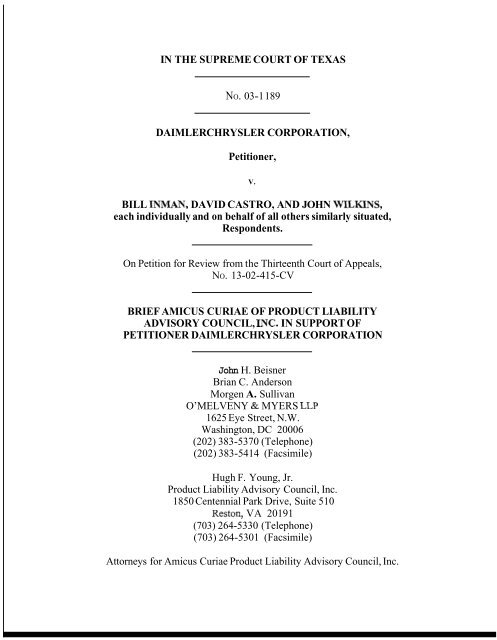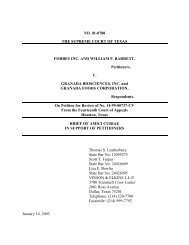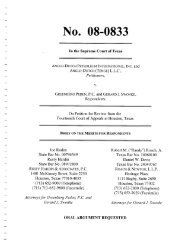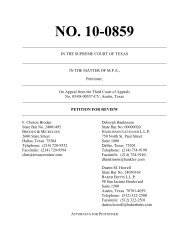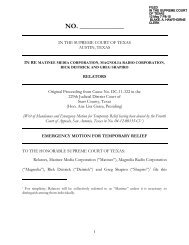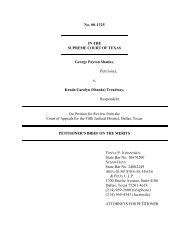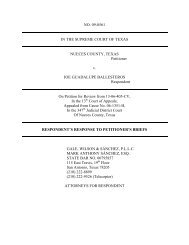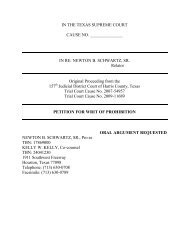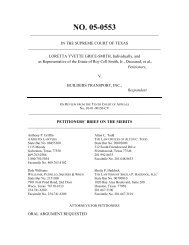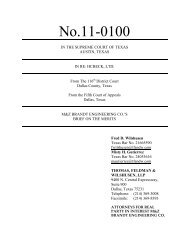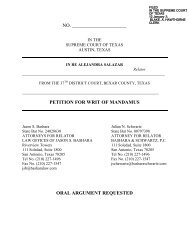DAIMLERCHRYSLER CORPORATION, Petitioner - Supreme Court ...
DAIMLERCHRYSLER CORPORATION, Petitioner - Supreme Court ...
DAIMLERCHRYSLER CORPORATION, Petitioner - Supreme Court ...
Create successful ePaper yourself
Turn your PDF publications into a flip-book with our unique Google optimized e-Paper software.
IN THE SUPREME COURT OF TEXAS<br />
NO. 03-1 189<br />
<strong>DAIMLERCHRYSLER</strong> <strong>CORPORATION</strong>,<br />
<strong>Petitioner</strong>,<br />
V.<br />
BILL INMAN, DAVID CASTRO, AND JOHN WILKINS,<br />
each individually and on behalf of all others similarly situated,<br />
Respondents.<br />
On Petition for Review from the Thirteenth <strong>Court</strong> of Appeals,<br />
NO. 13-02-415-CV<br />
BRIEF AMICUS CURIAE OF PRODUCT LIABILITY<br />
ADVISORY COUNCIL, INC. IN SUPPORT OF<br />
PETITIONER DAIMLERCHRY SLER <strong>CORPORATION</strong><br />
John H. Beisner<br />
Brian C. Anderson<br />
Morgen A. Sullivan<br />
O’MELVENY & MYERS LLP<br />
1625 Eye Street, N.W.<br />
Washington, DC 20006<br />
(202) 383-5370 (Telephone)<br />
(202) 383-5414 (Facsimile)<br />
Hugh F. Young, Jr.<br />
Product Liability Advisory Council, Inc.<br />
1850 Centennial Park Drive, Suite 510<br />
Reston, VA 20191<br />
(703) 264-5330 (Telephone)<br />
(703) 264-5301 (Facsimile)<br />
Attorneys for Amicus Curiae Product Liability Advisory Council, Inc.
IDENTITY OF PARTIES AND COUNSEL<br />
The following persons have an interest in the outcome of this case, or are counsel<br />
for such persons. These representations are made in accordance with Rule 38.1 of the<br />
Texas Rules of Appellate Procedure so that the judges of this court may evaluate possible<br />
disqualification or recusal.<br />
PLAINTIFFSRESPONDENTS<br />
Bill L. Inman, David Castro and John Wilkins, each individually<br />
and On Behalf of all Others Similarly Situated,<br />
Trial and Apoellate Counsel<br />
Steven A. Kanner<br />
William H. London<br />
Douglas A. Millen<br />
Much Shelist Freed Denenberg<br />
Ament gi Rubenstein, P.C.<br />
200 N. La Salle Street, Suite 2100<br />
Chicago, IL 60601-1095<br />
(312) 346-3100<br />
J. Mitchell Clark<br />
Law Offices of J. Mitchell Clark<br />
Frost Bank Plaza<br />
802 N. Carancahua, Suite 1650<br />
Corpus Christi, TX 78470<br />
(361) 887-8500<br />
William R. Edwards, I11<br />
William R. Edwards<br />
John Blaise Gsanger<br />
The Edwards Law Firm, L.L.P.<br />
P.O. Box 480<br />
Corpus Christi, TX 75403-0480<br />
i
Vernon N. Reaser, Jr.<br />
Law Offices of Vernon Reaser, Jr.<br />
202 Pecan Drive<br />
Victoria, TX 77905-0686<br />
(361) 576-5858<br />
DEFENDANT/PETITIONER<br />
<strong>DAIMLERCHRYSLER</strong> <strong>CORPORATION</strong> (fikla Chrysler Corporation),<br />
Chrysler Corporation and Chrysler<br />
Trial and Appellate Counsel<br />
William V. Dorsaneo 111<br />
Suellen Ratliff<br />
Mark S. Whitburn<br />
Gibson, Dunn & Crutcher, LLP<br />
2 100 McKinney Avenue, Suite 1 100<br />
Dallas, TX 75201-691 1<br />
(214) 698-3100<br />
Mike A. Hatchell<br />
Molly H. Hatchell<br />
Locke Liddell & Sapp, LLP<br />
100 Congress Avenue, Suite 300<br />
Austin, TX 78701<br />
(512) 305-4700<br />
Theodore J. Boutrous Jr.,<br />
Gibson, Dunn & Crutcher, LLP<br />
333 South Grand Avenue<br />
Los Angeles, CA 90071-3197<br />
(213) 229-7000<br />
..<br />
I 11
TABLE OF CONTENTS<br />
Page<br />
IDENTITY OF PARTIES AND COUNSEL .................................................................................<br />
INDEX OF AUTHORITIES .........................................................................................................<br />
INTEREST OF AMICUS C b J .............................................................................................. 1<br />
STATEMENT OF THE CASE ...................................................................................................... 2<br />
STATEMENT OF JURISDICTION .............................................................................................. 2<br />
ISSUES PRESENTED FOR REVEEW ......................................................................................... 2<br />
STATEMENT OF FACTS .................................. ................................<br />
SUMMARY OF ARGUMENT .....................................................<br />
ARGUMENT .............................................................................................<br />
I. NAMED PLAINTIFFS’ ASSERTION OF “NO INJURY” CLAIMS<br />
UNDER TEXAS LAW MAKES THEM INADEQUATE CLASS<br />
REPRESENTATIVES AND RENDERS CLASS LITIGATION<br />
INFERIOR TO ALTEFWATE FORMS OF DISPUTE RESOLUTION. ........<br />
11.<br />
111.<br />
SOUND POLICY REASONS JUSTIFY DENYING RECOGNITION OF “NO<br />
INKRY” LAWSUITS ...................................................................................................... 6<br />
THE OVERWHELMING WEIGHT OF AUTHORITY HOLDS THAT “NO<br />
INJURY CLASS ACTION LAWSUITS ARE NOT VIABLE ............. ....... 14<br />
IV. REFUSAL TO RECOGNIZE “NO INJURY“ CLASS ACTIONS WOULD NOT<br />
LEAVE PLAINTIFFS WITHOUT A POTENTIAL REMEDY ..................................... 20<br />
coNcLusIoN ........................................... ................................... ........................... 22<br />
CERTIFICATE OF SERVICE<br />
TAB A: CORPORATE MEMBERS OF THE PRODUCT LIABILITY<br />
ADVISORY COUNCIL<br />
i<br />
iv<br />
...<br />
111
INDEX OF AUTHORITIES<br />
CASES<br />
Page<br />
Accardo v. Bridgestone-Firestone, Inc.,<br />
No. 44495 (40th Judicial Dist. Ct., St. John the Baptist Parish,<br />
La., Apr. 21, 2004) ...................................................................................................... 15<br />
American Suzuki Motor COY v Superior <strong>Court</strong>,<br />
44 Cal. Rptr. 2d 526 (CafCt.,4pp. 1995) ...................................................... 15, 16, 20<br />
Angus v. Shiley Inc.,<br />
989 F.2d 142 (3d Cir. 1993) ................................................................................. 15,18<br />
Barbarin v. Gen. Motors Corp.,<br />
No. 84-0858, 1993 WL 765821 (D.D.C. Sept. 22, 1993) ........................................... 15<br />
Barbe v. A.A. Harmon & Co.,<br />
705 So. 2d 1210 (La. App. 1998) ............................................................................... 16<br />
Briehl v. General Motors Corp.,<br />
172 F.3d 623 (8th Cir. 1999) ................................................................................ assim<br />
Capital Holding Cor v Bailey,<br />
873 S.W.2d 1874':<br />
Ky 1994) ........................................................................................ 15<br />
Carlson v. Gen. Motors Corp.,<br />
883 F.2d 287 (4th Cir. 1989) ................................................................................ 15, 20<br />
Chin v. Chlysler Corp.,<br />
182 F.R.D. 448 (D.N.J. 1998) ............................................................................... 14, 15<br />
DaimlerChrysler Corp. v. Inman,<br />
121 S.W.3d 862 (Tex. Ct. App. 2003) ................................................................ 4, 6, 19<br />
Feinstein v. Firestone Tire &Rubber Co.,<br />
535 F. Supp. 595 (S.D.N.Y. 1982) ....................................................................... 15, 18<br />
Ford Motor Co. v. Rice,<br />
726 So. 2d 626 (Ala. 1998) ............................................................................. 15, 16, 20<br />
Frank v. DaimlerChysler Corp.,<br />
741 N.Y.S.2d 9 (N.Y. App. Div. 2002) ............................................................ 8, 15,20<br />
Green v. Gen. Motors Corp.,<br />
No. A-2831-01T-5,2003 WL 21730592 (N.J. Super. App. Div.<br />
July 10, 2003) ....................................................................................................... 15, 16<br />
Hubbard v. Gen. Motors Corp.,<br />
No. 95 Civ. 4362, 1996 WL 274018 (S.D.N.Y. May 22, 1996) .................... 14, 15,20<br />
In re Air Bag Prods. Liab. Litig.,<br />
7 F. Supp. 2d 792 (E.D. La. 1998) ........................................................................ 14, 15<br />
In re Bridgestone/Firestone, Inc. Tires Prods. Liab. Litig.,<br />
288 F.3d 1012 (7th Cir. 2002) .............................................................................. assim<br />
In re General Motors Anti-Lock Brake Prods. Liab. Litig.,<br />
966 F. Supp. 1525 (E.D. Mo. 1997) ........................................................................... 17
INDEX OF AUTHORITIES<br />
Page<br />
In re Rhone-Poulenc Rorev Inc.,<br />
51 F.3d 1293 (7th Cir . 1995) ........................................................................................ 9<br />
Jarman v . United Indus . Corp.,<br />
98 F . Supp . 2d 757 (S.D. Miss . 2000) ........................................................................ 19<br />
Lavelle v . Owens-Corning Fibevglas COT? .,<br />
507 N.E.2d 476 (Ohio Ct . Corn . P1 . 1987) ................................................................. 15<br />
Lee v . Gen . Motors Corp.,<br />
950 F . Supp . 170 (S.D. Miss . 1996) ........................................................................... 15<br />
Martin v . Ford Motor Co.,<br />
914 F . Supp . 1449, n.9 (S.D. Tex . 1996) .............................................................. 15, 16<br />
Orlando v . Fin . One. Inc.,<br />
369 S.E.2d 882 (W. Va . 1988) .................................................................................... 16<br />
Polaris Indus., Inc . v . McDonald,<br />
119 S.W.3d 331 (Tex . Ct . App . 2003) .......................................................................... 6<br />
Schweitzer v . Consol . Rail Corp.,<br />
758 F.2d 936 (3d Cir . 1985) ......................................................................................... 9<br />
Spuhl v . Shiley. Inc.,<br />
795 S.W.2d 573 (Mo. Ct . App . 1990) ........................................................................ 15<br />
Wallis v . Ford Motor CO.,<br />
No . CV-2002-154-2 (Ark. Cir . Ct . Jan . 15, 2004) ...................................................... 15<br />
Weaver v . Chrysler Corp.,<br />
172 F.R.D. 96 (S.D.N.Y. 1997) ...................................................................... 15, 18, 20<br />
Willett v . Baxtev Int’l, Inc.,<br />
929 F.2d 1094 (5th Cir . 1991) ...................................................................... 7, 8, 15, 18<br />
Yost v . Gen . Motors Corp.,<br />
651 F . Supp . 656 (D.N.J. 1986) .................................................................................. 15<br />
Yu v . IBM Corp.,<br />
732 N.E.2d 1173 (Ill. App . Ct . 2000) ......................................................................... 15<br />
Ziegelmaizn v . Dnimler Chlysler Corp.,<br />
649 N.W.2d 556 (N.D. 2002) ................................................................... 15, 16, 17, 20<br />
STATUTES AND RULES<br />
49 U.S.C. 5 30118 ............................................................................................................ 21<br />
49 U.S.C. 5 30120 ............................................................................................................ 21<br />
49 U.S.C. 5 30162 ...................................................................................................... 20, 21<br />
Tex . Bus . & Corn . Code 5 17.565 .................................................................................... 13<br />
Tex . R . Civ . P . 42 ......................................................................................................... 4, 23<br />
V
INDEX OF AUTHORITIES<br />
OTHER AUTHOFUTIES<br />
Page<br />
I<br />
Class Action Fairness Act of 2000, S. REP.<br />
106-420, 106th Cong., 2d Sess. 16 (2000).................................................................. 22<br />
Class Action Fairness Act of 2002, H. REP.<br />
107-370, 107th Cong., 2d Sess. 14 (2002).................................................................. 22<br />
John H. Beisner & Jessica Davidson Miller,<br />
They’re Making a Federal Case Out of It ... In State <strong>Court</strong>,<br />
25 HARV. J. L. PUB. POL’Y 143 (Winter 2001) ........................................................... 22<br />
John H. Beisner & Jessica Davidson Miller, Class Action Magnet <strong>Court</strong>s:<br />
The Allure Intensifies, 4 BNA CLASS ACTION LITIG. REP. 58<br />
(Jan. 24, 2002) ............................................................................................................ 22<br />
Peter Huber, Safety and the Second Best: The Hazards of Public Risk<br />
Management in the <strong>Court</strong>s, 85 COLUM. L. REV. 277 (1985) ..................................... 21<br />
s<br />
Richard A. Posner, A The0 ry o Negligence,<br />
1 J. LEGAL STUD. 29 (1972 ........................................................................................ 12<br />
Richard C. Ausness, The Case for n “Strong” Regulatory Compliance<br />
Defense, 55 MD. L. REV. 1210 (1996)........................................................................ 21<br />
W. Page Keeton, et al.,<br />
PROSSER & KEETON ON THE LAW OF TORTS (5th ed. 1984) ...................................... 14<br />
vi
INTEREST OF AMICUS CURIAE<br />
The Product Liability Advisory Council, Inc. (“PLAC”) is a non-profit association<br />
with 132 corporate members representing a broad cross-section of American and<br />
international product manufacturers.<br />
These companies seek to contribute to the<br />
improvement and reform of law in the United States and elsewhere, with emphasis on the<br />
law governing the liability of manufacturers of products. PLAC’s perspective is derived<br />
from the experiences of a corporate membership that spans a diverse group of industries<br />
in various facets of the manufacturing sector. Since 1983, PLAC has filed hundreds of<br />
briefs as amicus cuviae in both state and federal courts, including this <strong>Court</strong>, to present<br />
the broad perspective of product manufacturers seeking fairness and balance in the<br />
application and development of the law as it affects product liability. A list of PLAC’s<br />
corporate members is attached at Tab A,’<br />
PLAC and its members maintain a significant interest in this appeal because the<br />
<strong>Court</strong> of Appeals misunderstood the fatal flaws associated with “no injury” lawsuits, such<br />
as this one, which should bar them from proceeding, at minimum, past the class<br />
certification stage. The <strong>Court</strong> of Appeals’ approach dramatically expands the litigation<br />
costs for sellers and manufacturers by interpreting Texas standing and class certification<br />
law to extend the potential liability of manufacturers and sellers to consumers never<br />
injured by the product at issue. Not only is the <strong>Court</strong> of Appeals ruling on injury wrong<br />
as a matter of law, it also has been rejected nearly uniformly by the courts of other states.<br />
’ Pursuant to Texas Rule of Appellate Procedure ll(c), PLAC affirms that it received no outside funding for the<br />
preparation of this brief.
If allowed to stand, the ruling in this case will lead to a flood of baseless class action<br />
lawsuits that would impose undue burdens and expense on the courts of this state and on<br />
the manufacturers and sellers that such suits will target.<br />
STATEMENT OF THE CASE<br />
PLAC adopts the Defendant’s-<strong>Petitioner</strong>’s statement of the case.<br />
STATEMENT OF JURISDICTION<br />
PLAC adopts the Defendant’s-<strong>Petitioner</strong>’s statement of jurisdiction.<br />
ISSUES PRESENTED FOR REVIEW<br />
PLAC adopts the Defendant’s-<strong>Petitioner</strong>’s statement of the issues presented for<br />
review.<br />
STATEMENT OF FACTS<br />
PLAC adopts the Defendant’s-<strong>Petitioner</strong>’s statement of facts.<br />
SUMMARY OF ARGUMENT<br />
This is the latest instance of a class action lawsuit that need not, and should not,<br />
ever have been filed. Here, plaintiffs seek a monetary award for themselves and all other<br />
purchasers of certain motor vehicles, even though those vehicles have not malfunctioned,<br />
. ,<br />
!<br />
1<br />
and have not caused their owners any injury or loss. To the contrary, this lawsuit seeks a<br />
windfall payment for people whose products have performed precisely as expected.<br />
While the named plaintiffs’ lack of standing itself bars class certification in this<br />
case, their inability to assert a legally cognizable claim under Texas law also creates<br />
adequacy and superiority problems fatal to class certification. <strong>Court</strong>s across the country,<br />
when confronted with “no injury” claims like those asserted here, have almost<br />
2<br />
1
unanimously arrived at the same conclusion: Unless a product has maljiunctioned or<br />
caused actual injury, its owner cannot seek relief in the courts. They have adopted this<br />
principle regardless of how the plaintiff has styled his or her claim-ie., whether pled in<br />
negligence, strict liability, warranty, or common law or statutory fraud. They have<br />
rejected “no injury” claims regardless of the theory of proof the plaintiff invokes- ie.,<br />
whether the seller allegedly misrepresented the product, an alleged unreasonable danger<br />
exists, or the product allegedly failed to conform to some industry or other standard.<br />
They have rejected such claims regardless of how the plaintiff describes his supposed<br />
damages--i.e.,<br />
whether viewed in terms of the risk of future failure of the product,<br />
diminution in the value of the product, or loss of the benefit of the bargain and cost of<br />
repair. Simply put, courts throughout the United States, when confronted with situations<br />
identical to the one here, have chosen the straightforward course of limiting judicial relief<br />
to those who have actually been harmed.<br />
This doctrine demonstrates that plaintiffs lack standing to assert their claims - a<br />
prerequisite to pursuing a proposed class action. But it also demonstrates that plaintiffs<br />
cannot be deemed adequate representatives of the proposed class - their basic inability to<br />
assert even a plausible claim renders them incapable of representing a class of those who<br />
ostensibly have potentially viable claims against defendants. And it demonstrates that<br />
class litigation is not the superior way to resolve the philosophical debate over seat belt<br />
design that lies at the core of this lawsuit; abstract debates over the risks vs. benefits of<br />
different designs are best presented to the automobile industry’s federal regulatory<br />
agency - the National Highway Traffic Safety Administration. While juries are well-<br />
3
suited to considering actual damage claims by actual victims of allegedly defective<br />
products, they are not well-suited to making highly nuanced automobile design decisions<br />
for the entire country.<br />
Because this rule reflects sound considerations of fairness, efficiency, and<br />
institutional competence, PLAC respectfully urges this <strong>Court</strong> to reverse the judgment<br />
below on standing grounds, or, alternatively, for the failure to meet the certification<br />
requirements of Rule 42<br />
ARGUMENT<br />
I. NA4MED PLAINTIFFS’ ASSERTION OF “NO INJURY” CLAIMS<br />
UNDER TEXAS LAW MAKES THEM INADEQUATE CLASS<br />
REPRESENTATIVES AND RENDERS CLASS LITIGATION INFERIOR<br />
TO ALTERNATE FORMS OF DISPUTE RESOLUTION.<br />
DaimlerChrysler argued to the <strong>Court</strong> of Appeals that the named plaintiffs lacked<br />
standing to bring any claims due to the absence of allegations that they incurred a legally<br />
cognizable physical, property, or monetary injury. The <strong>Court</strong> of Appeals held that<br />
standing existed.<br />
But it reached that conclusion by so watering down the injury<br />
requirement for standing that everyone with an abstract sense of disappointment about<br />
some aspect of the products they buy can meet it. Even if the <strong>Court</strong> of Appeals were<br />
correct in its standing analysis-ie.,<br />
that the injury question is a merits issue and that<br />
purely theoretical grievances constitute “injury” for standing purposes, see<br />
DairnlerChvysler Corp. v. Inman, 121 S.W.3d 862, 885 (Tex. Ct. App. 2003)-its<br />
standing holding demonstrates that class certification is inappropriate for two other<br />
reasons.<br />
4
First, the named plaintiffs are inadequate class representatives because they lack<br />
an even facially cognizable claim. As Texas purchasers asserting “no injury” claims,<br />
named plaintiffs are governed by Texas law.<br />
Texas, like the majority of other<br />
jurisdictions, does not recognize “no injury” claims under any legal theory.* Thus, class<br />
adjudication based on the legally inadequate damage allegations of the named plaintiffs’<br />
claims would drag down the claims of those other purchasers who potentially have viable<br />
claims because they (unlike named plaintiffs) allegedly suffered personal injury, property<br />
damage, or actual out-of-pocket money damages. See State Farm Mut. Auto. Ins. Co. v.<br />
Lopez, 2004 Tex. LEXIS 1249, at *12-*12-*13, *I9 (Tex. Dec. 3,2004) (citing Cuwen v.<br />
Bank United, 70 F.3d 937, 941-42 (7th Cir. 1995) (“A decision that the claim of the<br />
named plaintiffs lacks merit ordinarily . . . disqualifies the named plaintiffs as the proper<br />
class representatives.”)).’<br />
Second, given that a class judgment in this case, which by definition is brought<br />
only on behalf of people who have not been injured, would bar any vehicle owner who<br />
suffers personal injury or property damage in the future from bringing claims based on<br />
the purported design defect in their vehicles, a “no injury” class action is not superior to<br />
While this <strong>Court</strong> has not yet ruled on the “no injury” issue as currently presented, the lower courts of this state<br />
tend to reject the idea that such claims are viable, see, e.g., Gen. Motors Corp. v. Gana, No. 04-03-00702-CV, 2005<br />
Tex. App. LEXIS 532, at *19 (Tex. Ct. App. Jan. 26,2005), and for this reason and the reasons that follow, the<br />
<strong>Court</strong> should clarify Texas law by squarely rejecting “no injury” claims.<br />
’ See Amchem Prods., Inc. v. WindJor, 521 US. 591, 625-27 (1997) (denying certification of class alleging both<br />
risk of injury and manifested injury due to inadequacy of named plaintiffs because “’a class representative must . . .<br />
possess the same interest and suffer the same injury’ as the class members”); Robinson v. SherifofCook Cq., 167<br />
F.3d 1155, 1157-58 (7th Cir. 1999) (“if [named plaintiffs] claim is a clear loser at the time he asks to be made class<br />
representative, then approving him as class representative can only hurt the class”); Ardoin v. Stine Lumber Co., 220<br />
F.R.D. 459, 466-67 (W.D. La. 2004) (‘?t is this disparity of claims that prevents the plaintiffs from meeting the<br />
commonality requirement, and it is the consequences of not recognizing the disparity of these claims that prevents<br />
the class members from adequately representing the class.”); In re Ford Motor Co. Bronco 11 Prod. Liab. Litig., 177<br />
F.R.D. 360, 366-68 (E.D. La. 1997) (“by attempting to tailor their action in such a way as to improve their ability to<br />
establish commonality, class representatives may in fact create an adequacy problem”).<br />
5
individual litigation of real claims stemming from real injuries, if and when they arise.<br />
See Polaris Indus., Inc. v. McDonald, 119 S.W.3d 331,344-45 (Tex. Ct. App. 2003).<br />
Whether resolved as an issue of a lack of standing due to the lack of any legally<br />
cognizable injury, <strong>Petitioner</strong>’s Brief on the Merits, at 8-20, or as a bar to class<br />
certification due to the inadequacy of named plaintiffs and absence of superiority<br />
resulting from the claims asserted by named plaintiffs, see sup7*a, there are fundamental<br />
legal and policy problems with “no injury” class action lawsuits that this <strong>Court</strong> can<br />
address now, and that counsel against this case proceeding any further (at least with<br />
respect to any nationwide class with Texas named plaintiff purchasers or a Texas class).<br />
Given the extensive briefing on standing already before the <strong>Court</strong>, PLAC will confine its<br />
discussion to the reasons for rejecting “no injury” claims (and thus how the “no injury”<br />
issue affects adequacy and superiority).‘<br />
11. SOUND POLICY REASONS JUSTIFY DENYING RECOGXITIOX OF<br />
“NO INJURY” LA\VSUITS.<br />
Plaintiffs’ claims are premised on one core factual allegation - that Gen-3<br />
seatbelt buckles purportedly have a tendency to accidentally release. See Innman, 121<br />
S.W.3d at 876. None of the plaintiffs, however, alleges ever experiencing an accidental<br />
release incident that resulted in personal injury or property damage. In other words,<br />
plaintiffs do not allege that the purported defects ever caused them any actual injury.<br />
While there is no need to resolve any choice of law issue before ruling on the “no injury” issue (as there is no<br />
debate that Texas law applies to named plaintiffs) and the bar it creates for class certification, PLAC also notes that<br />
a nationwide class action remains uncertifiable due to variations in state law. See <strong>Petitioner</strong>’s Brief on the Merits, at<br />
26-31; see also Inman, 121 S.W.?d at 855-86.<br />
6
Although each plaintiff is basically alleging, “nothing ever happened to me,” each<br />
demands a substantial, immediate monetary payment.<br />
Plaintiffs seek to mask this flaw in their claims by speculating that something bad<br />
might happen in the future. Plaintiffs allege that ifacertain set of circumstances were to<br />
converge, there is a risk that because of its characteristics, their Gen-3 seatbelt buckles<br />
might accidentally release and cause injury and damage to themselves or others. Further,<br />
they allege that ifthey decide to sell their vehicle in the future, they may receive less than<br />
some amount to which they apparently believe they are entitled. See id. On the basis of<br />
this risk of potential future events, plaintiffs demand that they be paid money now.<br />
Texas and other courts do not permit such speculative damage claims to proceed<br />
as class actions. There are sound policy reasons for this rule. To start, courts reject “no<br />
injury” lawsuits because recognizing such suits would harm both consumers and<br />
manufacturers. In denying the validity of “no injury” claims similar to those that<br />
plaintiffs assert here, the Seventh Circuit explained that because the tort system fully<br />
compensates those who are injured by a defective motor vehicle, allowing “no injury”<br />
recoveries would result in both a windfall for plaintiffs whose vehicles never cause them<br />
injury and a distortion of the economic incentives on manufacturers.<br />
See In re<br />
Bridgestoize/Firestone, Inc. Tires Prods. Lid. Litig., 288 F.3d 1012, 1017 & n.1 (7th Cir.<br />
2002). Recognition of claims absent any manifest injury only drives up prices for all<br />
consumers.<br />
Judge John Minor Wisdom of the Fifth Circuit also discussed this point in Willett<br />
v. Bnxter International, he., 929 F.2d 1094 (5th Cir. 1991).<br />
In that case, plaintiffs<br />
7
sought money damages because they were allegedly at risk due to a “potentially fatal”<br />
defect in implanted heart valves.<br />
See id. at 1096. Approximately 19,000 patients<br />
received similar heart valves, but only seventeen valves malfunctioned. See id. As the<br />
court explained, “[tlhe damages of the seventeen are presumably incorporated into the<br />
price of the product and spread among the nineteen thousand who have purchased the<br />
valve.” Id. at 1100 11.20. However. the court concluded that it would be unwise and<br />
premature to allow 19,000 individuals, all of whom contend that they are at risk of<br />
someday experiencing the malfunction in fact experienced by only a few, to demand a<br />
monetary payment:<br />
Id.<br />
Because [under a regime permitting “no injury” claims] no loss-spreading<br />
occurs, the money flows in a circle, from each patient (in the form of a<br />
higher price) to the company back to the same patient (in the form of a fear<br />
recovery), with a substantial portion of the higher price skimmed off for<br />
attorneys’ fees. In addition, the higher price will place the product beyond<br />
the economic reach of at least some of the patients, forcing them to turn to<br />
the next best (affordable) alternative. We see little reason to adopt such a<br />
system.<br />
Thus, as many courts have recognized, if “no injury” lawsuits are permitted, some<br />
consumers may gain in the short run. In the long run, however, all consumers lose.<br />
Consumers would bear the burden of higher prices to cover manufacturers’ costs of<br />
5<br />
Accord Lee v. Gen. Motors Corp., 950 F. Supp. 170, 175 (S.D. Miss. 1996) (“If <strong>Court</strong>s were to allow cases such as<br />
this to go forward, the costs of doing business would be so burdensome and so expensive that suppliers,<br />
manufacturers, and most consumers would suffer greatly. The only persons that would benefit by permittin, 0 cases<br />
such as this to go forward would he the lawyers handling the case and perhaps the few consumers directly involved<br />
in the litigation.”); Frank v. DaimlerChrysler Corp., 741 N.Y.S.2d 9, 16-17 (N.Y. App. Div. 2002) (recognizing that<br />
allowing “no injury” claims would “have a profound effect on the marketplace, as they would increase the cost of<br />
manufacturing, and therefore the price of evciyday goods to compensate consumers who claim to have a better<br />
design, or fear certain products might fail”).<br />
8
outinely making (or defending against) windfall payments for the mere risk of injury.<br />
Meanwhile, consumers who actually experience tangible injuries would receive smaller<br />
awards. See Schweitzer v. Consol. Rail Corp., 758 F.2d 936, 942 (3d Cir. 1985) (stating<br />
that unless “manifest injury” is required, “windfalls [will be awarded to] . . . those who<br />
never take ill” and those who suffer will receive “insufficient compensation”).<br />
Such “no injury” lawsuits often are filed as class actions to justify the expenses of<br />
the litigation. Recognition of “no injury” lawsuits thus encourages plaintiffs to bring the<br />
largest class action imaginable in order to create “blackmail” settlement pressure on the<br />
defendant notwithstanding the lack of merit of the allegations. See In re Rhone-Poulenc<br />
Rorer Znc., 51 F.3d 1293, 1298-99 (7th Cir. 1995). As a result, the economic distortions<br />
identified by Judge Wisdom and others are even more astounding when considering that<br />
the invocation of the class device multiplies the distortions millions of times over and<br />
browbeats defendants into paying huge settlements for meritless claims.6<br />
In addition, a host of negative practical effects for Texas courts and Texas citizens<br />
would flow from a decision to open the door to “no injury” lawsuits. As the new hub for<br />
“no injury” product liability class actions, it is safe to say that courts of this state would<br />
be flooded with lawsuits seeking to redesign products to alleviate the possibility of future<br />
accidents. After all, if Texas nurtures product liability class actions based solely on a<br />
product’s potential risk, almost every product in existence today could be the object of a<br />
6<br />
And assuming, contrary to Texas precedent, see suppra, that preclusion principles did not bar the bringing of a later<br />
claim based on personal injury or propeity damage, economic distortions still exist because allowing injured and<br />
uninjured consumers alike to assert product liability claims would generate a windfall to many consumers through<br />
double recovery (as presumably the vast majority of class members would not use their “no injury” recovery to<br />
remedy the alleged harm) while burdening manufacturers with much more than’the actual cost of the harm generated<br />
by a particular design defect. See Bririgestone/Fil.estne, 288 F.3d at 1017 & n.1.<br />
9
lawsuit.<br />
Any lawyer’s idea about how a product might be made safer could be<br />
transformed into a class action lawsuit seeking to require the manufacturer to reconfigure<br />
all of its previously sold products in a manner more to the particular plaintiffs liking.<br />
The ability to file a lawsuit while enjoying a fully functional product that has never failed<br />
to meet the suing purchaser’s real-world needs would lead to litigants from all over the<br />
country lining up in Texas courthouses.<br />
Moreover, Texas courts and juries would find themselves in the unfamiliar role of<br />
being asked to serve as product standard review committees in charge of making<br />
prospective decisions about what product specifications would best protect the public<br />
safety-a function which the courts and juries of any state would be ill-equipped to<br />
handle.<br />
To understand the absurdity of a regime in which juries of randomly selected<br />
laypeople are given the power to pronounce large numbers of consumer products<br />
“defective” simply because a “risk” exists that they will not always perform as desired,<br />
imagine two courtrooms in the same courthouse. In <strong>Court</strong>room A, a class action is<br />
brought on behalf of owners of vehicles with old-fashioned conventional brakes. The<br />
argument is advanced that kaditional brakes are “defective” because they can lock up in<br />
an emergency, leading to skids and accidents. Pictures of “conventional brake” accident<br />
victims are shown (albeit not those who are bringing suit). Memos from company<br />
engineers criticizing conventional brakes are introduced.<br />
An expert opines that<br />
conventional brakes are defective. A skilled trial lawyer makes an emotional attack on<br />
conventional brakes, arguing that they are obsolete and should be replaced with more<br />
10
sophisticated anti-lock brakes. The jury agrees, and awards all owners of vehicles with<br />
conventional brakes money damages. As a result, the manufacturer stops installing<br />
outmoded conventional brakes, switching instead to modern anti-lock brakes.<br />
In <strong>Court</strong>room B, a class action is brought on behalf of all owners of vehicles with<br />
the risky new technology of anti-lock brakes. The argument is advanced that anti-lock<br />
brakes are “defective” because most drivers do not instinctively operate them effectively<br />
(ie., by applying constant pressure rather than pumping) in an emergency. Pictures of<br />
“anti-lock brake” accident victims are shown (albeit not those who are bringing suit).<br />
Memos from company engineers expressing concern about anti-lock brakes are<br />
introduced. An expert opines that anti-lock brakes are defective. A skilled trial lawyer<br />
makes an emotional attack on anti-lock brakes as constituting an inadequately validated,<br />
ill-conceived gamble with peoples’ lives. The jury agrees, and awards all owners of<br />
vehicles with anti-lock brakes money damages. As a result, the manufacturer stops<br />
installing “risky” anti-lock brakes, returning instead to more tried-and-true conventional<br />
brakes.<br />
The foregoing hypothetical is not far-fetched. These kinds of “damned-if-you-do;<br />
damned-if-you-don’t’’ class actions are filed all the time. Fortunately, most are dismissed<br />
on ‘‘no injury” grounds. But the above example demonstrates that allowing juries to<br />
overrule complex product design decisions in the name of an entire nation of consumers<br />
gives too much power to a randomly chosen group of lay people with neither the<br />
expertise nor the resources to make these kinds of broad decisions for society as a whole.<br />
It is one thing for a jury to find that an individual plaintiff was injured by a defective<br />
11
product, and to order the manufacturer to compensate that plaintiff for his injuries. If the<br />
jury’s judgment is “wrong,” the consequences of its error are nevertheless manageable<br />
(unless the jury is allowed to impose confiscatory punitive damages). But it is quite<br />
another thing to empower a jury to pronounce an entire family of products “defective” in<br />
the abstract, and effectively order them off the market in the context of a class action<br />
lawsuit in which no plaintiff or absentee class member has been injured. Such lawsuits<br />
can compel manufacturers to make debilitating windfall payments to purchasers who<br />
have enjoyed full value from their products, and interfere with the inevitable balancing<br />
exercises that underlie any product’s design. Strict adherence to the “injury” requirement<br />
preserves the former category of lawsuits, while precluding the latter.<br />
Few manufacturers would possess the capacity to comply with constantly shifting<br />
product improvement ideas devised by various courts and juries if courts did not<br />
rigorously enforce the injury requirement that supports both the standing doctrine and is<br />
an element of most common law and statutory causes of action. Once made, those<br />
judicial product design determinations would stifle needed innovation by discouraging<br />
product manufacturers from developing new, improved designs that may differ from<br />
those already “court approved.” Cf: Richard A. Posner, A Theory of Negligence, 1 J.<br />
LEGAL STUD. 29, 32-33 (1972) (explaining how traditional principles of negligence law<br />
enable manufacturers to internalize costs). Predicating causes of action upon real injury<br />
prevents this chaos and preserves the judiciary’s role as arbiter of concrete cases and<br />
controversies.<br />
12
In addition, the sanctioning of “no injury” claims may adversely impact public<br />
safety. For example, this lawsuit attacks an entire category of seat belts installed on large<br />
numbers of automobiles as defective - essentially useless. Yet, at the same time, the<br />
public interest demands that seat belt usage be encouraged. If reckless allegations that<br />
seat belts are defectivelunmerchantableiuseless are allowed to gain traction in the context<br />
of “no injury” class actions, the public may embrace the cynical message that motor<br />
vehicle safety components are ineffective, and hence are not worthy of usage. The irony<br />
of “no injury” lawsuits that, like this one, purport to advance public safety, is that the<br />
reckless abstract attacks upon the design of vehicle safety components that such lawsuits<br />
so often employ may ultimately discourage consumers from supporting and using those<br />
safety devices, to the ultimate detriment of public safety.<br />
Finally, were courts to indulge lawsuits based on far-fetched notions of consumer<br />
‘” injury” (ie.,“risk” of future injury; diminution in value because the product is “less<br />
safe” than the consumer ostensibly believed it would be), that policy would generate<br />
undesirable distortions in other aspects of civil law. For example, the two-year statute of<br />
limitations for actions under the Texas Deceptive Trade Practices Act, see Tex. Bus. &<br />
Com. Code 3 17.565, would begin to run as soon as a consumer knew or should have<br />
known of a product defect, even if the product continued to perfom satisfactorily. Such<br />
a rule could trigger an avalanche of lawsuits from uninjured consumers who seek<br />
damages for unquantified risks of product failure or injury. Even worse, it would leave<br />
injured consumers without a cause of action if the injury-ie.,<br />
a real injury-occurred<br />
more than two years after they knew or should have known of the product defect. This<br />
13
absurd result underscores why the mere existence of a risk of the manifestation of a<br />
product defect cannot possibly be regarded as a judicially recognized harm.<br />
111. THE OVERWHELMING WEIGHT OF AUTHORITY HOLDS THAT (‘NO<br />
INJURY” CLASS ACTION LAWSUITS ARE NOT VIABLE.<br />
<strong>Court</strong>s require a plaintiff to plead more than the mere possibility of a future legal<br />
injury in order to recover damages. Absent injury, a person does not experience anything<br />
the law can remedy. As one of America’s leading legal commentators put it, “[tlhe threat<br />
of future harm, not yet realized, is not enough.” W. Page Keeton, et al., PROSSER &<br />
KEETON ON THE LAW OF TORTS, 3 30, at 165 (5th ed. 1984). Accordingly, courts<br />
repeatedly hold in product defect cases that “[plurchasers of an allegedly defective<br />
product have no legally recognizable claim where the alleged defect has not manifested<br />
itself in the product they omm.” Hubbavd v. Gen. Motors Covp., No. 95 Civ. 4362, 1996<br />
WL 274018, at *3 (S.D.N.Y. May 22, 1996). <strong>Court</strong>s thus consistently reject “no injury,”<br />
“increased risk,” and “tendency to fail” cases, whether based on tort, fraud, warranty or<br />
unjust enrichment theories, or on state statutory consumer protection provisions. “[Tlhe<br />
common thread of the cases” is always the same in that “the absence of manifest injury is<br />
so fundamental a deficiency. . . that such claims are more appropriately dismissed than<br />
preserved.” In re Air Bug Prods. Lid. Litig., 7 F. Supp. 2d 792, 804 (E.D. La. 1998).<br />
The vast majority of courts considering the “no injury” issue, including courts<br />
applying Texas law, agree that such lawsuits based solely on a product’s alleged<br />
“propensity to fail” state no legally cognizable injury.<br />
Several state courts have<br />
7<br />
“In most jurisdictions, the courts recognize that unless a product actually mamfests the alleged defect, no cause of<br />
action for breach of express or implied warranty or fraud is actionable.” Chin v. Chrysler Corp., 182 F.R.D. 448,<br />
14
460 (D.N.J. 1998); see, e.g., Garza, 2005 Tex. App. LEXIS 532, at *I9 (“For purchasers who never experienced a<br />
problem during the time they owned the car, they got what they paid for - a vehicle that provided transportations<br />
with a brake system that safely stopped the car.”); Wallis v. Ford Motor Co., No. CV-2002-154-2, slip op. at 1-2<br />
(Ark. Cir. Ct. Jan. 15, 2004) (dismissing fraud and consumer protection act claim based on an “allegedly<br />
unreasonable tendency to roll over” because “plaintiff has not experienced a cognizable injury or damages as a result<br />
of the alleged defect”); Accardo v. Bririgesfone-Firestone, Inc., No. 44495, slip op. at 3 (40th Judicial Dist. Ct., St.<br />
John the Baptist Parish, La., Apr. 21, 2004) (dismissing redhibition and unjust enrichment claims based on same<br />
allegations for a lack of any legally cognizable injury); Green v. Gen. Motors Corp., KO. A-2831-01T-5, 2003 WL<br />
21730592, at *6-*9 (N.J. Super. App. Div. July 10, 2003) (barring “no injury” claim under warranty law and<br />
consumer protection act); Frank, 741 N.Y.S.2d at 11, 16 (rejecting claim that vehicle backrests were “susceptible to<br />
rearward collapse” because “it would be manifestly unfair to require a manufacturer to become, in essence, an<br />
indemnifier for a loss that may never occur”); Ziegelmann v. Daimler Chlysler Corp., 649 N.W.2d 556, 565 (N.D.<br />
2002) (complaint alleging defect in vehicle because lack of park-brake interlock device “failed to plead any legally<br />
cognizable injury’’ where “[tlhe gist of [complaint] is that the vehicle might malfunction and cause injury in the<br />
future”); Ford Motor Co. v. Rice, 726 So. 2d 626, 627, 631 (Ala. 1998) (holding that plaintiffs could not pursue<br />
claim for fraudulent suppression involving Bronco I1 vehicles with alleged tendency to roll over where the “alleged<br />
product defect . . . has not manifested itself in such a way as to cause any observable adverse physical or economic<br />
consequences.”); Am. SuzukiMotor Corp. v. Superior <strong>Court</strong>, 37 Cal. App. 4th 1291, 1296 (1995) (where class action<br />
plaintiffs allege that they have suffered no personal injury or propew damage from an allegedly defectively<br />
designed vehicle they cannot state a cause of action for breach of implied warranty); Yu v. IBM Corp., 732 N.E.2d<br />
1173, 1177-78 (Ill. App. Ct. 2000) (dismissing consumer fraud and negligence action due to lack of actual injury or<br />
damages); Capital Holding Corp. v. Bailey, 873 S.W.2d 187, 192 (Ky. 1994) (holding that no cause of action<br />
accrues with respect to defective product “until the potentially harmful [product] actually ‘causes injury that<br />
produces loss or damage”’) (quotations and citation omitted); Spuhl v. Shiley, Inc., 795 S.W.2d 573, 580 (Mo. Ct.<br />
App. 1990) (rejecting failure to warn claims because plaintiff did not allege “failure or malfunction of the product”);<br />
Lavelle v. Owens-Corning Fiberglas Corp., 507 N.E.2d 476, 479 (Ohio Ct. Com. P1. 1987) (barring claim alleging<br />
increased risk of cancer because “the injury, and the damages resulting, must be shown with certainty, and not be<br />
left to speculation or conjecture, whether the action is in contract or tort; damages which are uncertain, speculative,<br />
or conjectural cannot be recovered”) (internal quotation marks and citation omitted); Eriehl v. Gen. Motors Corp.,<br />
172 F.3d 623, 628-29 (8th Cir. 1999) (dismissing plaintiffs’ wide-ranging set of claim (i.e., fraudulent<br />
misrepresentation, fraudulent concealment, breach of implied warranty, state consumer protection statute, breach of<br />
express warranty, and breach of contract) due to no injury); Angus v. Shiley, Inc., 989 F.2d 142, 148 (3d Cir. 1993)<br />
(disallowing no injury claim concerning allegedly defective heart valves because law not intended to “sanction a<br />
large, if not vast, number of lawsuits by consumers who obtained properly functioning valves”); Willett v. Barter<br />
Int’l, Inc., 929 F.2d 1094, 1099-1100 (5th Cir. 1991) (same); Carlson v. Gen. Motors Corp., 883 F.2d 287, 291 (4th<br />
Cir. 1989) (dismissing tort and implied warranty claims by “named plaintiffs who did not allege that they<br />
encountered engine difficulties with their own cars”); Feinstein v. Firestone Tire & Rubber Co., 535 F. Supp. 595<br />
(S.D.N.Y. 1982) (rejecting implied warranty claims asserted on behalf of vehicle owners who had experienced<br />
failure-free performance from their Firestone tires, notwithstanding the claim that tires were inherently defective and<br />
likely to fail); In re Air Bag Prods. Lid Litig., 7 F. Supp. 2d at 804 (dismissing tort and implied warranty claim<br />
brought by putative class alleging defective air bags because “the absence of manifest injury is so fundamental a<br />
deficiency. . . that such claims are more appropriately dismissed than preserved”); Martin v. Ford Motor Co., 914 F.<br />
Supp. 1449, 1454-56 & n.9 (S.D. Tex. 1996) (“[Tlhe manufacture of an unsafe vehicle itself, if such has indeed<br />
occurred, cannot constitute the cause of injury to Plaintiffs [without damage.]”); Weaver v. Chlysler Coi-p., 172<br />
F.R.D. 96, 100 (S.D.N.Y. 1997) (“Where, as here, a product perfom satisfactorily and never exhibits the alleged<br />
defect, no cause of action lies.”); Lee, 950 F. Supp. at 174-75 (rejecting claims that roofs on sport-utility vehicles<br />
were defective where plaintiffs experienced no defects in their vehicles); Hubbard, 1996 WL 274018, at *3<br />
(S.D.N.Y. May 22, 1996) (“[A] Suburban that perfom satisfactorily and never exluhits the alleged braking system<br />
defect is fit for the purposes intended ”); BarbaFin v. Gen. Motors Corp., No. 84-0888, 1993 WL 765821, at *2<br />
(D.D.C. Sept. 22, 1993) (“The court will . . . dismiss the claims of all plaintiffs whose X-cars never experienced the<br />
phenomenon of ‘premature rear wheel lock-up . . . .”’); Yosf v. Gen. Motors Corp., 651 F. Supp. 656 (D.N.J. 1986)<br />
(dismissing complaint for fraud and breach of warranty for failure to state a claim where plaintiff could only allege<br />
that vehicle was likely dangerous).<br />
15
addressed this issue and have denied the legal viability of the “no injury” claims asserted<br />
here. For example, in American Suzuki Motor Corp. v. Superior <strong>Court</strong>, 44 Cal. Rptr. 2d<br />
I ’,<br />
526 (Cal. Ct. App. 1995), the court held that where class action plaintiffs allege that they<br />
have suffered no personal injury or property damage from an allegedly defectively<br />
designed vehicle, it is impliedly conceded that their vehicles have remained tit for their<br />
ordinary use and they cannot state a cause of action for breach of implied warranty. Id. at<br />
527-28. In Ford Motor Co. v. Rice, 726 So. 2d 626 (Ala. 1998), the Alabama <strong>Supreme</strong><br />
<strong>Court</strong> held that plaintiffs could not pursue a claim for fraudulent suppression involving<br />
Bronco I1 vehicles with an alleged tendency to roll over where the “alleged product<br />
defect . . . has not manifested itself in such a way as to cause any observable adverse<br />
physical or economic consequences.” Id. at 627,631.<br />
Recently, the North Dakota <strong>Supreme</strong> <strong>Court</strong> unanimously affirmed the dismissal of<br />
a suit for negligence and fraudulent concealment where the plaintiff, alleging no personal<br />
injury, property damage, or vehicle malfunction, sought damages for the alleged<br />
diminution in value of his vehicle due to its allegedly defective transmission, the cost of<br />
repair, and the cost of substitute transportation during repair. See Ziegelmann v. Daimler<br />
Ckiysler Corp., 649 N.W.2d 556, 558-59 (N.D. 2002). The court concluded, “like the<br />
vast majority of courts that have considered similar no-injury product liability lawsuits,<br />
And numerous courts apply the actual injury requirement to consumer protection statutes. See, e.g., Briehl, 172<br />
F.3d at 628-29 (implicating, inter alia, Missouri and Mississippi law and a ffing dismissal of statutory consumer<br />
protec,tion claim); Martin, 914 F. Supp. at 1455 (rejecring claim under Texas statute for “no injury”); Green, 2003<br />
WL 21730592, at *8 (holding “no ascertainable loss’,’ existed under statute); Barbe v. A.A. Harmon & Co., 705 So.<br />
2d 1210, 1221 (La. App. 1998) (holding that claim could not be maintained under Louisiana consumer protection<br />
statute when plaintiff suffered no “ascertainable loss . . . as a result of‘ defendant’s conduct); Orlando v. Fin. One,<br />
Inc., 369 S.E.2d 882, 888 (W. Va. 1988) (finding no “ascertainable loss of money or property” under West Virginia<br />
law when unlawful loan clause was not enforced by defendant).<br />
16
[the plaintiffs] claim of injury is simply too speculative to constitute a legally cognizable<br />
tort injury.” Id. at 565. The case law demonstrates that it does not matter what state law<br />
cause of action a plaintiff alleges. Whether he or she asserts claims for negligence,<br />
breach of warranty, consumer protection violations, or equitable relief, the law recognizes<br />
that absent a present, manifest injury, the plaintiff lacks a legally viable injury.<br />
Rulings by federal courts go the same way. For example, in Briehl v. General<br />
Motors Covp., 172 F.3d 623 (8th Cir. 1999), plaintiffs brought a purported class action<br />
alleging that their vehicles contained anti-lock braking systems that had a “tendenc[y]” to<br />
fail by causing drivers to “misapply the brakes during emergencies where braking is<br />
required.” Id. at 626. The plaintiffs defined the proposed class to cover owners of the<br />
vehicles containing the allegedly defective braking systems, not cars in which the braking<br />
system actually failed. See id. at 626 n.6. The district court dismissed plaintiffs’ wide-<br />
ranging set of claims (i.e., fraudulent misrepresentation, fraudulent concealment, breach<br />
of implied warranty, violation of a state consumer protection statute, breach of express<br />
warranty, and breach of contract). See In re Gen. Motors Anti-Lock Brake Prods. Liab.<br />
Litig., 966 F. Supp. 1525, 1528 (E.D. Mo. 1997). The Eighth Circuit affirmed. Noting<br />
that “[c]ourts have been particularly vigilant in requiring allegations of injury or damages<br />
in products liability cases,” the court held that<br />
[wlhere, as in this case, a product performs satisfactorily and never exhibits<br />
an alleged defect, no cause of action lies. Since the Plaintiffs have failed to<br />
allege any manifest defect and their vehicles perform in a satisfactory<br />
manner, the District <strong>Court</strong> was correct when it dismissed the Plaintiffs’<br />
Original Complaint.<br />
17
Bviehl, 172 F.3d at 627, 628 (footnotes omitted). See also, e.g., Angus, 989 F.2d at 147-<br />
48; Willett, 929 F.2d at 1099-1100 (same).<br />
Federal district courts also have routinely rejected “no injury” theories in productrelated<br />
cases. For example, in Feinstein v. Firestone Tire & Rubber Co., 535 F. Supp.<br />
595 (S.D.N.Y. 1982), the Southern District of New York rejected implied warranty<br />
claims asserted on behalf of vehicle owners experiencing failure-free performance from<br />
their tires notwithstanding plaintiffs’ claim that the tires were inherently defective and<br />
likely to fail. The court explained “Liability does not exist in a vacuum; there must be a<br />
showing of some damage, which then may lead to further issues of quantum. . . . [Tlire<br />
owners whose tires performed to their entire satisfaction cannot demonstrate, as a matter<br />
of law, the ‘fact of damage’ necessary to state a claim. . . .” Id. at 602 (emphasis<br />
omitted). Thus, plaintiffs’ lack of a “legally recognizable claim” necessarily precluded<br />
class certification. See id. at 603.<br />
Likewise, in Weaver v. Chrysler Corp., 172 F.R.D. 96 (S.D.N.Y. 1997), a<br />
purported class alleged that the shoulder belt clips on certain vehicle seats were defective<br />
due to a propensity to “improperly unlatch and separate.” Id. at 98. The court held that<br />
the plaintiff had “failed to state a claim for fraud, negligent misrepresentation, and breach<br />
of warranty because he ha[d] not sufficiently pleaded damages.” Id. at 99. In reaching<br />
its conclusion, the court explained that “[wlhere, as here, a product performs<br />
satisfactorily and never exhibits the alleged defect, no cause of action lies.” Id. at 100.<br />
Indeed, the U.S. <strong>Court</strong> of Appeals for the Seventh Circuit recently confronted a<br />
similar alleged “propensity to rollover” defect in Ford Explorers and a “tendency to<br />
18
suffer tread separation” defect in Firestone tires, and reiterated the fundamental principle<br />
that manifest injury is required for recovery under either a contract-based or tort-based<br />
theory. See Bridgestone/Firestone, 288 F.3d at 1017. Plaintiffs, who, like plaintiffs here,<br />
had not alleged any malfunction or other manifestation of a defect in their vehicles, had<br />
tried to avoid this rule by “describ[ing] the[ir] injury as financial rather than physical and<br />
seek[ing] to move the suit out of the tort domain and into that of. . . consumer fraud (on<br />
the theory that selling products with undisclosed attributes, and thus worth less than<br />
represented, is fraudulent).” Id. The court recognized the majority position on the matter<br />
and the public policy reasons against allowing such cases, see infra, and noted that, “[als<br />
a result, most states would not entertain the sort of theory that plaintiffs press.” Id.<br />
Moreover, plaintiffs cannot dodge the fatal problem with their claims by alleging<br />
that any individual plaintiff was injured because he or she ostensibly would have paid a<br />
lower price if plaintiff knew of the alleged defects or because the value of the product has<br />
“diminished” in an abstract sense (even if the plaintiff has not sold the product and<br />
therefore cannot demonstrate any concrete loss). Znman, 121 S.W.3d at 876. <strong>Court</strong>s have<br />
refused to permit such attempts to circumvent the injury requirement:<br />
The point of the cases cited [I is that unless there is actually a<br />
failure in product performance, there is no basis at all for<br />
claiming that the plaintiff has been damaged in any way.<br />
Mere suspicion of a lost bargain . . . will not support an<br />
award of damages.<br />
Jarman v. United Indus. Corp., 98 F. Supp. 2d 757, 768 (S.D. Miss. 2000) (emphasis<br />
added) (rejecting argument of entitlement to recover the loss of the benefit of purchase<br />
price for an allegedly defective pesticide in action involving, inter din, breach of<br />
19
warranty, fraud, and misrepresentation claims).’ Accordingly, all of the named plaintiffs,<br />
and the classes they seek to represent, fail to allege legally cognizable injury.<br />
IV.<br />
REFUSAL TO RECOGNIZE “NO INJURY” CLASS ACTIONS WOULD<br />
NOT LEAVE PLAINTIFFS WITHOUT A POTENTIAL REMEDY.<br />
In accepting the policy concerns discussed above, the <strong>Court</strong> need not worry that<br />
plaintiffs can do nothing about the alleged seatbelt buckle defect until they become<br />
victims of accidents they claim can result from the alleged defect. As numerous courts<br />
recopnize, “[tlhe remedy which will best promote consumer safety, and which will<br />
address real parties’ concern that ‘tragic consequences’ will result if the defect is not<br />
remedied, is to petition the National Highway Traffic Safety Administration (NHTSA)<br />
for a defect investigation.” Am. Suzuki, 44 Cal. Rptr. 2d at 531 (footnote omitted);<br />
accord Ziegelmann, 649 N.W.2d at 564; Frank, 741 N.Y.S.2d at 17; Rice, 726 So. 2d at<br />
631. Congress has charged NHTSA with ensuring that individuals with a substantiated<br />
fear of injury from a motor vehicle defect may obtain systemic relief, and it has granted<br />
NHTSA the power to order manufacturers to remedy vehicle defects free of charge. See<br />
49 U.S.C. $5 30118(b), 30120(a).<br />
NHTSA adheres to a statutorily mandated process for receiving and addressing<br />
consumer petitions for defect investigations.<br />
“Any interested person” may petition<br />
* See, e.g, Weaver, 172 F.R.D. at 99-100 (rejecting claim that plaintiff had paid more for his vehicle than he would<br />
have had he known of his defect, concluding that “[wlhere, as here, a product performs satisfactorily and never<br />
exhibits the alleged defect, no cause of action lies”); Briehl, 172 F.3d at 628-29 (“Plaintiffs’ assertion that their<br />
ABS-equipped vehicles are defective and that they have suffered a loss in resale value as a result of the defect is<br />
insufficient as a matter of law to plead a claim under any theory the Plaintiffs have advanced.”); Curlson, 883 F.2d<br />
at 298 (affirming dismissal “of those plaintiffs who alleged damages attributable only to ‘lost resale value”’);<br />
HubbaFd, 1996 US. LEXIS Dist. 6974, at *%I0 (rejecting claim that plaintiffs would not have bought vehicles had<br />
they known of the alleged defect because plaintiffs had no legally cognizable cause of action due to “no injury”).<br />
20
NHTSA to launch an investigation to determine whether a motor vehicle-related product<br />
contains a safety-related defect.<br />
See 49 U.S.C. $ 30162.<br />
If NHTSA finds that the<br />
product suffers from a defect, it must then order the manufacturer to remedy the problem<br />
free of charge. See id. $$ 30118(b), 30120(a). The petition need contain nothing more<br />
than a simple statement of facts supporting the request for administrative action and a<br />
brief description of the relief desired. See 49 U.S.C. $ 30162(b). And NHTSA must<br />
“publish the reasons for [any] denial of a petition.” Id. 9 30162(d).9<br />
Equipped with flexible tools for fact gathering from industry and safety experts,<br />
and with its own reservoir of accumulated expertise, NHTSA is better situated than a<br />
court or lay jury to evaluate various product designs, and to implement preventive and<br />
global remedies where defects are found.<br />
Unlike courts, which resolve only<br />
individualized disputes “that have ripened (or are about to ripen) into concrete injuries,”<br />
Peter Huber, Safety and the Second Best: The Hazards of Public Risk Management in the<br />
<strong>Court</strong>s, 85 COLUM. L. REV. 277, 331 (1985), one of the core functions of agencies like<br />
NHTSA is to deal with systemic problems requiring prospective relief.<br />
Created to<br />
impose systemic remedies, agencies maintain a natural advantage over courts in that they<br />
have access to a wide range of expertise and resources which enables them to conduct<br />
thorough investigations and craft appropriate remedies. See Richard C. Ausness, The<br />
Case for a “Strong” Regulatory Compliance Defense, 55 MD. L. REV. 1210, 1219<br />
(1996). As the Seventh Circuit recently observed “Regulation by the NHTSA, coupled<br />
9<br />
Of course, hJTSA need not await a complaint from a private party before it can initiate proceedings examining<br />
product safety. In addition, the Texas Attorney General and the Texas Motor Vehicle Board maintain authority to<br />
address unfair trade practices and warranty issues. See Tex. Bus. & Corn. Code 5 17.47; Tex. Occ. Code $5<br />
2301.602, 2301.603, 2301.801, 2301.802.<br />
21
with tort litigation by persons suffering physical injury, is far superior to a suit by<br />
millions of uninjured buyers for dealing with consumer products that are said to be<br />
failure-prone.’’ Bridgestone/Firestone, 288 F.3d. at 1019. In short, when thousands or<br />
millions of “plaintiffs seek relief for an alleged defect that has not yet manifested itself or<br />
caused damage . . ., the administrative remedy provided by NHTSA . . . is more<br />
appropriate than civil litigation.” In re Ford Motor Co. Ignition Switch Prods. Liab.<br />
Litig., 174 F.R.D. 332, 353 (D.N.J. 1997).<br />
coNcLusIoN<br />
Unless this <strong>Court</strong> takes a firm position to bar the prosecution of lawyer-driven “no<br />
injury” lawsuits, Texas’s courts will become a “magnet” for nationwide class actions that<br />
have no real connection to the state (and that require the courts to apply the regulatory<br />
regimes of other states).” Over time, “no injury” class actions would severely tax the<br />
state’s judicial resources. And, as the evidence indicates, the flood of cases likely will do<br />
little to vindicate consumer rights. Instead, such cases will produce settlements where the<br />
lawyers walk off with most (if not all) of the monetary recovery.” And the judicial time<br />
consumed by those cases will deprive Texans sustaining real injuries of the ability to<br />
access to their own courts.<br />
’’<br />
See John H. Beisner & Jessica Davidson Miller, They ‘re Making a Federal Case Out of It. . . In State <strong>Court</strong>, 25<br />
HARV. J. L. PUB. POL’Y 143, 160 (Winter 2001); John H. Beisner & Jessica Davidson Miller, Class Action Magnet<br />
<strong>Court</strong>s: The Allure Intensifies, 4 BNA CLASS ACTION LITIG. REP. 58,59 (Jan. 24,2002).<br />
11<br />
See Class Action Fairness Act of2002, H. REP. 107-370,107th Cong., 2d Sess. 14 (2002); Class Action Fairness<br />
Act of2000, S. REP. 106-420,106th Cong., 2d Sess. 16 (2000).<br />
22
For all of the foregoing reasons, the plaintiffs case should be dismissed for a lack<br />
of standing. Alternatively, the class claims should be dismissed for the failure to meet<br />
the certification requirements of Rule 42.<br />
i<br />
23
Dated: February 3,2005<br />
Respectfully submitted,<br />
&kin C. Anderson<br />
Morgen A. Sullivan<br />
O’MELVENY & MYERS LLP<br />
1625 Eye Street, N.W.<br />
Washington, D.C. 20006<br />
(202) 383-5370 (Telephone)<br />
(202) 383-5414 (Facsimile)<br />
Hugh F. Young, Jr.<br />
Product Liability Advisory Council, Inc.<br />
1850 Centennial Park Drive, Suite 5 10<br />
Reston, VA 20191<br />
(703) 264-5330 (Telephone)<br />
(703) 264-5301 (Facsimile)<br />
Attorneys for Amicus Curiae<br />
Product Liability Advisory<br />
Council, Inc.<br />
24
CERTIFICATE OF SERVICE<br />
I certify that on February 3,2005 copies of the foregoing Brief Amicus Curiae of<br />
Product Liability Advisory Council, Inc. forwarded via first class mail, postage prepaid,<br />
to the following counsel of record:<br />
Steven A. Kanner<br />
William H. London<br />
Douglas A. Millen<br />
Much Shelist Freed Denenberg<br />
Ament & Rubenstein, P.C.<br />
200 I?. La Salle Street, Suite 2100<br />
Chicago, IL 60601-1095<br />
(312) 346-3100<br />
J. Mitchell Clark<br />
Law Offices of J. Mitchell Clark<br />
Frost Bank Plaza<br />
802 N. Carancahua, Suite 1650<br />
Corpus Christi, TX 78470<br />
(361) 887-8500<br />
William R. Edwards, 111<br />
William R. Edwards<br />
John Blaise Gsanger<br />
The Edwards Law Firm, L.L.P.<br />
P.O. Box 480<br />
Corpus Christi, TX 78403-0480<br />
Vernon I?. Reaser, Jr.<br />
Law Offices of Vernon Reaser, Jr.<br />
202 Pecan Drive<br />
Victoria, TX 77905-0686<br />
(361) 576-5858<br />
Attorneys for PlaintiffsRespondents<br />
William V. Dorsaneo I11<br />
Mike A. Hatchell<br />
Suellen Ratliff<br />
Molly H. Hatchell<br />
Mark S. Whitburn<br />
Locke Liddell & Sapp, LLP<br />
Gibson, Dunn & Crutcher, LLP 100 Congress Avenue, Suite 300<br />
2100 McKinney Avenue, Suite 1100 Austin, TX 78701<br />
Dallas, TX 75201-6911 (512) 305-4700<br />
(214) 698-3100
Theodore J. Boutrous Jr.,<br />
Gibson, Dunn & Crutcher, LLP<br />
333 South Grand Avenue<br />
Los Angeles, CA 90071-3197<br />
(213) 229-7000<br />
DATED: February 3,2005.<br />
Attorneys for Defendantipetitioners<br />
A<br />
P<br />
H. Beisner<br />
rian C. Anderson<br />
Morgen A. Sullivan<br />
O’MELVENY & MYERS LLP<br />
1625 Eye Street, N.W.<br />
Washington, D.C. 20006<br />
(202) 383-5370 (Telephone)<br />
(202) 383-5414 (Facsimile)<br />
Hugh F. Young, Jr.<br />
Product Liability Advisory Council, Inc.<br />
1850 Centennial Park Drive, Suite 510<br />
Reston, VA 20191<br />
(703) 264- 5 3 3 0 (Telephone)<br />
(703) 264-5301 (Facsimile)<br />
Attorneys for Amicus Curiae<br />
Product Liability Advisory<br />
Council, Inc.<br />
2
Corporate Members of the<br />
Product Liability Advisory Council<br />
as of 1110/2005<br />
3M<br />
Altec Industries<br />
Altria Corporate Services, Inc.<br />
American Household, Inc.<br />
American Suzuki Motor Corporation<br />
Amgen Inc.<br />
Andersen Corporation<br />
Anheuser-Busch Companies<br />
Appleton Papers, Inc.<br />
Arai Helmet, Ltd.<br />
Astec Industries<br />
Aventis Pharmaceuticals, Inc.<br />
BASF Corporation<br />
Bayer Corporation<br />
Beretta U.S.A Corp.<br />
BIC Corporation<br />
Biro Manufacturing Company, Inc.<br />
Black & Decker (U.S.) Inc.<br />
BMW of North America, LLC<br />
Boeing Company<br />
Bombardier Recreational Products<br />
BP America Inc.<br />
Bridgestone/Firestone, Inc.<br />
Briggs & Stratton Corporation<br />
Bristol-Myers Squibb Company<br />
Brown-Forman Corporation<br />
CARQUEST Corporation<br />
Caterpillar Inc.<br />
Chevron Corporation<br />
Continental Tire North America, Inc.<br />
Cooper Tire and Rubber Company<br />
Coors Brewing Company<br />
Crown Equipment Corporation<br />
DaimlerChrysler Corporation<br />
Deere & Company<br />
Delphi Corporation<br />
Diageo North America Inc.<br />
The Dow Chemical Company<br />
E & J Gallo Winery<br />
E.I. DuPont De Nemours and Company<br />
Eaton Corporation<br />
Eli Lilly and Company<br />
Emerson Electric Co.<br />
Engineered Controls International, Inc.<br />
Estee Lauder Companies<br />
Exxon Mobil Corporation<br />
FMC Corporation<br />
Ford Motor Company<br />
Freightliner LLC<br />
General Electric Company<br />
General Motors Corporation<br />
GlaxoSmithKline<br />
The Goodyear Tire & Rubber Company<br />
Great Dane Limited Partnership<br />
Guidant Corporation<br />
Harley-Davidson Motor Company<br />
Harsco Corporation<br />
The Heil Company<br />
Honda North America, Inc.<br />
Hyundai Motor America<br />
ICON Health &Fitness, Inc.<br />
Illinois Tool Works, Inc.<br />
International Truck and Engine Corporation<br />
Isuzu Motors America, Inc.<br />
Johnson & Johnson<br />
Johnson Controls, Inc.<br />
Joy Global Inc., Joy Mining Machinery<br />
Kawasaki Motors Corp., U.S.A.<br />
Kia Motors America, Inc.<br />
Koch Industries<br />
Kolcraft Enterprises, Inc.<br />
Kraft Foods North America, Inc.<br />
Lincoln Electric Company<br />
Masco Corporation<br />
Mazda (North America), Inc.<br />
McNeilus Truck and Manufacturing, Inc.<br />
Medtronic, Inc.<br />
Mercedes-Benz of North America, Inc.<br />
Michelin North America, Inc.<br />
Miller Brewing Company<br />
Niro Inc.<br />
NissanNorth America, Inc.<br />
Novartis Pharmaceuticals Corporation<br />
PACCAR Inc<br />
Panasonic<br />
Pentair, Inc.<br />
Pfizer Inc.<br />
Pharmacia Corporation<br />
Porsche Cars North America, Inc.<br />
PPG Industries, Inc.<br />
The Procter & Gamble Company<br />
Purdue Pharma L.P.<br />
Page 1
Corporate Members of the<br />
Product Liability Advisory Council<br />
as of 1/10/2005<br />
Putsch GmbH & Co.KG<br />
The Raymond Corporation<br />
Raytheon Aircraft Company<br />
Remington Arms Company, Inc.<br />
Rheem Manufactuting<br />
RJ Reynolds Tobacco Company<br />
Schindler Elevator Corporation<br />
SCM Group USA Inc.<br />
Shell Oil Company<br />
The Sherwin-Williams Company<br />
Smith & Nephew, Inc.<br />
Snap-on Incorporated<br />
Sofamor Danek<br />
Sturm, Ruger & Company, Inc.<br />
Subaru of America, Inc.<br />
Synthes (U.S.A.)<br />
Terex Corporation<br />
Textron, Inc.<br />
Thomas Built Buses, Inc.<br />
TK Holdings<br />
The Toro Company<br />
Toshiba America Incorporated<br />
Toyota Motor Sales, USA, Inc.<br />
TRW Automotive US LLC<br />
Tyson Foods, Inc.<br />
UST (U.S. Tobacco)<br />
Volkswagen of America, Inc.<br />
Volvo Cars ofNorth America, inc.<br />
Vulcan Materials Company<br />
Water Bonnet Manufacturing, Inc.<br />
Watts Water Technologies, Inc.<br />
Whirlpool Corporation<br />
Wyeth<br />
Yamaha Motor Corporation, U.S.A<br />
Yokohama Tire Corporation<br />
Zimmer, Inc.<br />
Page I


